Turneffe Flats
Registered
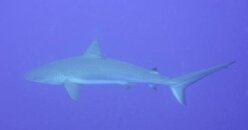
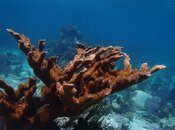
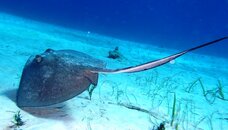
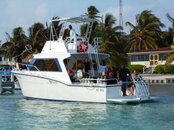
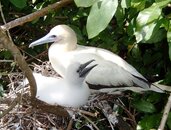
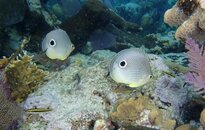
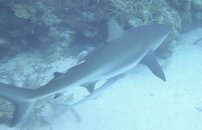
PHOTOS FOR THE WEEK
1 – 6 June, 2014
Air Temperatures – Low to Mid 80’s
Water Temperature – 82F
Winds from the east dominated the week blowing at speeds from 15 to 20 knots. Overcast conditions prevailed throughout the week with a few scattered showers, and a few periods of sunshine.
Boat Captain for the week was Carlton (AKA Capt), and dive guide were Divemaster Denroy, and Dive Instructor Anne-Marie. Two of the 10 divers in the group were doing REEF (Reef Environmental Education Foundation) fish surveys, and they were able to identify over 80 species of fish while diving for the week at both Turneffe and Lighthouse Reef. This is the fifth year that these two divers have joined us to do these surveys.
As we had some newer divers in the group, we took them to South and North Creekozene, as well as Black Pearl, all with 70 feet of visibility, and all on the west side of the atoll on the leeward side, for the first day of diving. The two divers doing the REEF fish surveys were kept busy right away with the host of colourful fish darting back and forth on these reefs. Sightings of note for the day were three Hawksbill Turtles, two large Remoras following divers, a 5-foot Great Barracuda that looked very skinny with its large head out sizing the rest of its body, three Sailfin Blennies, and a female Pike Blenny in the sand.
We headed for the northwest of Turneffe on Monday, day two, visiting Terrace, Chasbow’s Corner, and Elkin’s Bay. The first two sites offered 70 feet of visibility, with 60 feet of visibility at Elkin’s Bay. Interesting sightings for the day included three Hawksbill Turtles again, three Spotted Eagle Rays, another 5-foot Great Barracuda that looked healthy this time, Neck Crabs and a Cryptic Teardrop Crab that decorates itself with tiny bits of orange sponge attached to it for camouflage. Also, when we headed for the swim through at Elkin’s Bay, we discovered an 8-foot Nurse Shark resting peacefully on the sand in there. Of course, there would be no divers going through, however the shark became disturbed by the divers at close proximity, yet was unwilling to exit. This specimen was quite girthy, and without being able to check for claspers, we assumed this was a pregnant female.
Winds backed down to just over 10 knots on Tuesday morning, so we decided to make a run for Lighthouse Reef. We had 5 to 6-foot choppy seas in the beginning of the journey heading east after leaving the cover of the Turneffe barrier reef. However, these seas subsided after about 30 minutes as we got closer to Lighthouse Reef. None of our divers were interested in doing the Blue Hole, so we chose diving western Long Caye for the first two dives, drift diving from Painted Wall to the Aquarium for dive one, and from Quebrada to Long Caye Ridge for dive two, both with less than 60 feet of visibility. A 1-knot westerly current pushed us along at Painted Wall and seemed to come welling up or pushing down at times. It made for a fun ride, even though it felt like a bit of a washing machine. We found some very large Black Groupers hovering in the Deep Sea Gorgonian Sea Fans when we arrived at Aquarium near the end of the dive. Fair sized Yellow Fin Groupers were seen swimming around outcroppings below, and a small Caribbean Reef Shark was spotted swimming deep on this dramatic vertical wall. Permit, Tarpon and schooling Horse Eye Jack were spotted on dive two after we arrived at Long Caye Ridge near the end of the dive. This site has very interesting relief showcasing large blocks of coral heads along the edge of the sloping wall with deep grooves between where numerous reef fish including School Master and Mahogany Snappers like to gather. Of course, we stopped at Half Moon Caye for our fried chicken picnic lunch and visited the Red-Footed Booby Bird Sanctuary on the island during our break. We chose Half Moon Caye Wall for dive three where visibility was improved to 70 feet. This dive wound up being a bit of a sharkfest dive, making up for the absence of the Blue Hole dive from this itinerary, where one usually spots a few Caribbean Reef Sharks. It started out with divers observing Black, Nassau and Yellow Fin Groupers, more schooling Horse Eye Jacks, two Spotted Eagle Rays and a Green Turtle. Then, during the second half of the dive, one 6-foot Caribbean Reef Shark swam by along the wall, and circled back. Another 8-foot specimen swam up from the other direction on the wall, and then a third smaller shark of just under 5 feet in length joined them just as we were swimming over the reef wall and heading toward the sand area on the site. The two larger sharks swam around us for several minutes, following us onto the expansive sand bed there. They did not demonstrate any aggressive body posturing, and just seemed quite curious as they eyed us and circled around, giving everyone great photo opportunities.
On Wednesday, we were back to the west side of Turneffe and visited Amberhead, Pine Ridge and Lobster Bay, all with visibility of less than 60 feet. Many Caribbean Spiny Lobsters were found tucked under overhangs and reef heads, blissfully unaware of the impending Lobster Season about to start on 15 June here in Belize. Another Nurse Shark was found, but not as large as the one seen on Monday being only 5 feet in length.
We headed back to the northwest of the atoll on Thursday, our fifth day of diving, and worked Mandy’s Dandy, Molly’s Folly and Tunnels & Barrels, with visibility of 60 feet. Two Hawksbill Turtles were seen during the day of diving, and lots Green Moray Eels swimming between coral heads.
For our last day of the week on Friday, we braved the Elbow and did our dive there in 5-foot choppy seas. Although the tide was going out and there was a decent 1-knot current with 70 feet of visibility, the Elbow was not as active as it normally is in these conditions. However, we did see a large female Hawksbill Turtle munching on sponges, schooling Horse Eye Jacks, Rainbow Runners, Great Barracuda, and quite a few large Black Groupers. We tucked around to the west of the point and headed north during the surface interval choosing Tarpon Bay as our second dive. With only 60 feet of visibility, we were able to appreciate the beautiful coral formations and sponges scattered in the white sand bed along this sloping wall, and observed two Spotted Eagle Rays, and a Black-Spotted Nudibranch barely a half-inch long. On our third dive of the day, and last dive of the week, we chose Elgene’s Inn and found 60 feet of visibility there. Highlight sightings on the dive were schooling Ocean Triggers circling each other and gathering for spawning, two Spotted Eagle Rays, and we finally got our White Spotted Toadfish sighting in as we found one sitting neatly inside its tight coral crevace with a pile of white sand spilling from the opening.
1 – 6 June, 2014
Air Temperatures – Low to Mid 80’s
Water Temperature – 82F
Winds from the east dominated the week blowing at speeds from 15 to 20 knots. Overcast conditions prevailed throughout the week with a few scattered showers, and a few periods of sunshine.
Boat Captain for the week was Carlton (AKA Capt), and dive guide were Divemaster Denroy, and Dive Instructor Anne-Marie. Two of the 10 divers in the group were doing REEF (Reef Environmental Education Foundation) fish surveys, and they were able to identify over 80 species of fish while diving for the week at both Turneffe and Lighthouse Reef. This is the fifth year that these two divers have joined us to do these surveys.
As we had some newer divers in the group, we took them to South and North Creekozene, as well as Black Pearl, all with 70 feet of visibility, and all on the west side of the atoll on the leeward side, for the first day of diving. The two divers doing the REEF fish surveys were kept busy right away with the host of colourful fish darting back and forth on these reefs. Sightings of note for the day were three Hawksbill Turtles, two large Remoras following divers, a 5-foot Great Barracuda that looked very skinny with its large head out sizing the rest of its body, three Sailfin Blennies, and a female Pike Blenny in the sand.
We headed for the northwest of Turneffe on Monday, day two, visiting Terrace, Chasbow’s Corner, and Elkin’s Bay. The first two sites offered 70 feet of visibility, with 60 feet of visibility at Elkin’s Bay. Interesting sightings for the day included three Hawksbill Turtles again, three Spotted Eagle Rays, another 5-foot Great Barracuda that looked healthy this time, Neck Crabs and a Cryptic Teardrop Crab that decorates itself with tiny bits of orange sponge attached to it for camouflage. Also, when we headed for the swim through at Elkin’s Bay, we discovered an 8-foot Nurse Shark resting peacefully on the sand in there. Of course, there would be no divers going through, however the shark became disturbed by the divers at close proximity, yet was unwilling to exit. This specimen was quite girthy, and without being able to check for claspers, we assumed this was a pregnant female.
Winds backed down to just over 10 knots on Tuesday morning, so we decided to make a run for Lighthouse Reef. We had 5 to 6-foot choppy seas in the beginning of the journey heading east after leaving the cover of the Turneffe barrier reef. However, these seas subsided after about 30 minutes as we got closer to Lighthouse Reef. None of our divers were interested in doing the Blue Hole, so we chose diving western Long Caye for the first two dives, drift diving from Painted Wall to the Aquarium for dive one, and from Quebrada to Long Caye Ridge for dive two, both with less than 60 feet of visibility. A 1-knot westerly current pushed us along at Painted Wall and seemed to come welling up or pushing down at times. It made for a fun ride, even though it felt like a bit of a washing machine. We found some very large Black Groupers hovering in the Deep Sea Gorgonian Sea Fans when we arrived at Aquarium near the end of the dive. Fair sized Yellow Fin Groupers were seen swimming around outcroppings below, and a small Caribbean Reef Shark was spotted swimming deep on this dramatic vertical wall. Permit, Tarpon and schooling Horse Eye Jack were spotted on dive two after we arrived at Long Caye Ridge near the end of the dive. This site has very interesting relief showcasing large blocks of coral heads along the edge of the sloping wall with deep grooves between where numerous reef fish including School Master and Mahogany Snappers like to gather. Of course, we stopped at Half Moon Caye for our fried chicken picnic lunch and visited the Red-Footed Booby Bird Sanctuary on the island during our break. We chose Half Moon Caye Wall for dive three where visibility was improved to 70 feet. This dive wound up being a bit of a sharkfest dive, making up for the absence of the Blue Hole dive from this itinerary, where one usually spots a few Caribbean Reef Sharks. It started out with divers observing Black, Nassau and Yellow Fin Groupers, more schooling Horse Eye Jacks, two Spotted Eagle Rays and a Green Turtle. Then, during the second half of the dive, one 6-foot Caribbean Reef Shark swam by along the wall, and circled back. Another 8-foot specimen swam up from the other direction on the wall, and then a third smaller shark of just under 5 feet in length joined them just as we were swimming over the reef wall and heading toward the sand area on the site. The two larger sharks swam around us for several minutes, following us onto the expansive sand bed there. They did not demonstrate any aggressive body posturing, and just seemed quite curious as they eyed us and circled around, giving everyone great photo opportunities.
On Wednesday, we were back to the west side of Turneffe and visited Amberhead, Pine Ridge and Lobster Bay, all with visibility of less than 60 feet. Many Caribbean Spiny Lobsters were found tucked under overhangs and reef heads, blissfully unaware of the impending Lobster Season about to start on 15 June here in Belize. Another Nurse Shark was found, but not as large as the one seen on Monday being only 5 feet in length.
We headed back to the northwest of the atoll on Thursday, our fifth day of diving, and worked Mandy’s Dandy, Molly’s Folly and Tunnels & Barrels, with visibility of 60 feet. Two Hawksbill Turtles were seen during the day of diving, and lots Green Moray Eels swimming between coral heads.
For our last day of the week on Friday, we braved the Elbow and did our dive there in 5-foot choppy seas. Although the tide was going out and there was a decent 1-knot current with 70 feet of visibility, the Elbow was not as active as it normally is in these conditions. However, we did see a large female Hawksbill Turtle munching on sponges, schooling Horse Eye Jacks, Rainbow Runners, Great Barracuda, and quite a few large Black Groupers. We tucked around to the west of the point and headed north during the surface interval choosing Tarpon Bay as our second dive. With only 60 feet of visibility, we were able to appreciate the beautiful coral formations and sponges scattered in the white sand bed along this sloping wall, and observed two Spotted Eagle Rays, and a Black-Spotted Nudibranch barely a half-inch long. On our third dive of the day, and last dive of the week, we chose Elgene’s Inn and found 60 feet of visibility there. Highlight sightings on the dive were schooling Ocean Triggers circling each other and gathering for spawning, two Spotted Eagle Rays, and we finally got our White Spotted Toadfish sighting in as we found one sitting neatly inside its tight coral crevace with a pile of white sand spilling from the opening.



